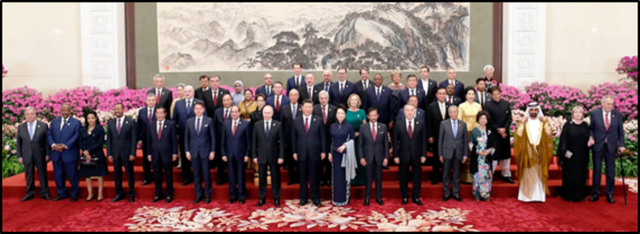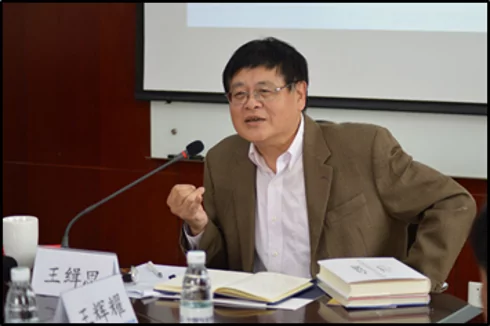
The Belt and Road Initiative: A Domestically-Motivated Program Fueling Global Competition
Publication: China Brief Volume: 20 Issue: 10
By:

Introduction
The Belt and Road Initiative (BRI), China’s ambitious overseas economic and infrastructure program, is having a significant impact on the world economy. The People’s Republic of China (PRC) has pledged $1 trillion in investment; the extensive geographic scope of the initiative involves more than 150 countries; there are a wide range of international organizations involved; and the initiative has brought China’s unpredictable political influence to the forefront of global affairs. Within China, the BRI is widely acknowledged as Beijing’s central diplomatic and economic policy.
The project is strongly associated with Chinese Communist Party (CCP) General Secretary and PRC President Xi Jinping, who announced the BRI in Kazakhstan and Indonesia in 2013. The Chinese database of Xi Jinping’s important speeches records President Xi as mentioning the BRI 1,653 times between February 7, 2014 and August 23, 2019—on average, once every 1.2 days (CCP News, 2020). Xi has also promoted the expansion of the BRI into areas beyond infrastructure—promoting, for example, construction of an international “Health Silk Road” in the wake of the COVID-19 pandemic (Xinhua, March 16). It could be argued that the future political success of President Xi is tied to the BRI—and that any fiasco of the initiative would ultimately damage Xi’s reputation.
After several years of implementation, the BRI can be regarded as a constantly evolving and ambiguously-defined program, covering almost every aspect of economic and political life in China. As Jonathan Hillman has stated, the BRI “is so big it is almost impossible for one person to have mastery of it. Sometimes I wonder if China grasps the whole thing.” [1] What has led the political leadership of the PRC to invest so much in this program, in terms of both resources and reputation? Foreign observers often discuss the BRI in terms of the PRC’s geopolitical ambitions—but in actuality, its primary motivating factors are domestic in origin.
The Domestic Motivations of the BRI
Per the Chinese government’s own statements, the BRI meets the internal requirements of China’s economic development; contributes to the expansion and deepening of Chinese economic reform; and the further integration of its domestic economy into the world economy, in an attempt to achieve sustainable development (Gov.cn, November 6, 2014; April 30, 2016). Some factors underpinning Chinese economic success over the past 40 years—such as low labor costs—have disappeared, which necessitates greater economic reforms. Without effective reforms, the Chinese economy is likely to meet significant difficulties, such as the dreaded “middle income trap” (China Brief, May 1). The prominent Chinese scholar Wang Jisi (王缉思), widely-perceived as an intellectual architect of the BRI, argues that:
Chinese manufacturers… are caught between developed countries, which dominate the most profitable ends of the supply chain, possess advanced technology, and are promoting recovery of their manufacturing sectors, and late-developing countries of the South, which are using their low production costs to catch up to their Chinese competitors (Gov.cn, April 30, 2016).

These comments reflect wide-ranging concerns in China regarding the improvement of the division of labor and distribution of industrial chains; the position of Chinese manufacturers in global value chains; and China’s domestic economic structural reform. Hu Huaibang (胡怀邦), the former Chairman of the China Development Bank, has stated that the BRI promotes China’s economic structural transformation and alleviates the pressure of industrial overcapacity by transferring domestic low-end manufacturing industries to the less developed countries along the BRI route (Opinion.people.cn, July 16, 2018). Meanwhile, the BRI drives the global expansion of construction engineering and high-speed rail, electric power, construction machinery, telecommunications, and other Chinese industries (Opinion.people.cn, July 16, 2018). Another significant motivation is the critical reliance of the Chinese economy “on accessing commodities, energy and raw materials” abroad, and the need “to find constantly growing overseas markets for its exports.” [2] The BRI fulfills both of these requirements.
Xi has also asserted that the BRI will drive the development of China’s frontier regions, thereby resolving issues of regional imbalance and instability (Gov.cn, April 30, 2016). It is evident that “a key challenge for Beijing since the establishment of the PRC in 1949 has been to integrate its traditional frontiers of Xinjiang, Tibet, Inner Mongolia, and Yunnan,” which have “non–Han Chinese ethnic populations, histories of autonomy, underdevelopment, geopolitically important position[s],” as well as potential issues with separatism. [3] Benefiting from Deng’s economic reform in 1978, the coastal regions of eastern China have rapidly advanced their economies, while the aforementioned traditional frontier provinces have significantly lagged behind. To solve these issues, the “Great Western Development Strategy” was put into effect at the end of the 1990s—and many aspects of the BRI are meant to continue those earlier policies.
It is conceivable that without the BRI, China might still implement its economic reforms, develop its frontier ethnic minority regions, and gain access to overseas raw materials and markets. However, although integrated into the global economy, the PRC still lacks the tools to project its economic power abroad. Rather than surrendering to the forces of market mechanisms, the BRI is the updated and strengthened version of the “Go Out policy” that was implemented at the end of the 1990s to encourage enterprises to invest overseas. More importantly, as Bruno Maçães argues, “a country will be unable to change its economy in a particular direction without altering the way the world economy is organized,” which encourages Beijing to design and formulate a global policy. The BRI is the solution by which China can “increase its control over the way value chains are organized and grant it the power to reorganize them on better terms.” [4]
The BRI’s Role in Security Competition and Ideological Struggle
The BRI offers an alternative economic model to that of Western countries. Due to the design and framework of the initiative, and the central role of state-owned enterprises (SOE) as the main participating corporations, the Chinese BRI model demands that “the state retain control over sectors that are considered strategic,” and that the economic development of a developing country should follow in the wake of infrastructure construction. [5] This indicates the “reaffirmation of the Chinese commitment to state capitalism” and an infrastructure-prioritized development path. [6]
Furthermore, this model holds that economic success can be achieved by good governance “rather than by the political architecture of Western liberal democracies and free market capitalism.” [7] Political entities always prioritize survival, and if the BRI is able to promote the Chinese model, Beijing can more effectively justify its rule to its domestic audience. For the Chinese government, “being active internationally is a matter of domestic political survival and arises because of potential domestic weakness.” [8]
Western observers often argue that the BRI was created intentionally to marginalize the United States in Asia, strengthen China’s regional influence, and diminish America’s global leadership. However, the above logic is an indication of the security dilemma in the region. Jessica Chen Weiss has argued that the PRC promotes defensive policies that seek “to make the world safer for Beijing”—but which have consequences that “threaten the values of liberal democracies overseas” (CSIS, October 21, 2019).
Conclusion: Rival Programs and Future Challenges to the BRI
The dynamic of security competition, and the increasing concern among some states about the BRI, is leading to a Western and Japanese response. In November 2019, the United States launched its “Blue Dot Network” (BDN) in conjunction with Australia and Japan. The declared intent of this project is to “bring together governments, the private sector, and civil society under shared standards for global infrastructure development,” and to “promote quality infrastructure investment that is open and inclusive, transparent, economically viable, financially, environmentally and socially sustainable, and compliant with international standards, laws, and regulations” (U.S. Department of State, undated).
Similarly, in September 2019, the European Union and Japan announced the “Partnership on Sustainable Connectivity and Quality Infrastructure” (PSCQI). This new program has the declared intent to promote “cooperation on connectivity and quality infrastructure with partner third countries and coordinate action, notably in the regions of the Western Balkans, Eastern Europe, Central Asia, Indo-Pacific, as well as in Africa,” and to “work together to promote openness, transparency, inclusiveness and a level playing field for those concerned… [to include] the ensuring of debt sustainability and the high standards of economic, fiscal, financial, social and environmental sustainability” (Japanese Ministry of Foreign Affairs, undated).
Even without mentioning China, it is not difficult to establish that the BDN and PSCQI projects are the Western strategic responses to Xi’s trademark initiative, in both the Indo-Pacific region and beyond. Conspicuously, both projects attempt to compete with the BRI by confronting that project’s comparative advantages. The multi-stakeholder approach in the BDN also contrasts with the SOE-centric, state domination of the BRI. The trusted standards, sustainable and principles-based development in the BDN and PSCQI contrast with the potential economic leverage and debt trap controversies surrounding the BRI. The BDN and PSCQI were created to challenge the BRI, a new form of competition that Beijing will have to face.
Jon (Yuan) Jiang is a Chinese PhD student in the Digital Media Research Centre at the Queensland University of Technology. He completed his master’s degree of political science at Moscow State Institute of International Relations, and bachelor’s degree of law at Shanghai University. He also worked with ZTE Corporation and as a special correspondent with Asia Weekly and Pengpai News, all in Moscow. His writing has also appeared in The Diplomat, The National Interest, South China Morning Post, CGTN, Global Times, Modern Diplomacy, U.S.-China Perception Monitor, People’s Daily and Caixin, as well as with the Russian International Affairs Council and Australian Institute of International Affairs. Follow his research on Twitter @ jiangyuan528.
Notes
[1] Bruno Maçães, Belt and Road: A Chinese World Order (Oxford Univ. Press, 2019), p. 8.
[2] Ibid., p. 17.
[3] Michael Clarke, “The Belt and Road Initiative: Chinas New Grand Strategy?” Asia Policy 24, no. 1 (2017): 71–79. https://doi.org/10.1353/asp.2017.0023.
[4] Maçães , Belt and Road: A Chinese World Order.
[5] Ibid., p. 42
[6]Matteo Dian and Silvia Menegazz, New Regional Initiatives in China’s Foreign Policy: The Incoming Pluralism of Global Governance (Palgrave MacMillan, 2018), p. 77.
[7] Li Xing (ed.), “China’s Pursuit of the ‘One Belt One Road’ Initiative: A New World Order with Chinese Characteristics?” (p. 14), in Mapping China’s One Belt One Road Initiative (Palgrave MacMillan, 2019).
[8] Milanovic, Branko. Capitalism, Alone: The Future of the System That Rules the World (Harvard Univ. Press, 2019), chapter 3.




